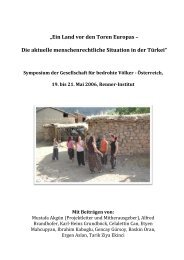Moderne Autonomiesysteme - Gesellschaft für bedrohte Völker
Moderne Autonomiesysteme - Gesellschaft für bedrohte Völker
Moderne Autonomiesysteme - Gesellschaft für bedrohte Völker
Sie wollen auch ein ePaper? Erhöhen Sie die Reichweite Ihrer Titel.
YUMPU macht aus Druck-PDFs automatisch weboptimierte ePaper, die Google liebt.
in ganz Indien geltenden Grundrechten vereinbar sein<br />
müssen.<br />
Somit ist der 6. Anhang offenkundig an seine Grenzen<br />
gestoßen, wie sie die Unruhen in North Cacahr,<br />
Karbi Anglong und Mizoram gezeigt haben. Einige<br />
Bereiche dieser Territorialautonomien wurden <strong>für</strong> das<br />
Autonomieabkommen des Bodolands erweitert. Doch<br />
schon das Gorkhaland (Darjeeling) will sich mit solchen<br />
Lösungen nicht mehr zufrieden geben. Der autonomen<br />
Distrikt Ladakh (Leh) und die Region Telengana in<br />
Andhra Pradesh sowie weitere kleinere <strong>Völker</strong> und<br />
indigene <strong>Völker</strong> in Zentralindien un din Nordostindien<br />
fordern ebenfalls regionale Selbstregierung oder<br />
Autonomie, am besten gleich einen eigenen Gliedstaat.<br />
Indien ist ein multiethnischer und multireligiöser Staat<br />
und betont immer wieder die nationale Integration,<br />
um Sezessionstendenzen gar nicht erst aufkommen<br />
zu lassen. Territorialautonomie könnte – wie in Europa<br />
– die meisten derartigen Konflikte befrieden, und ganz<br />
allgemein könnte die Stärkung von substaatlichen<br />
Regionen <strong>für</strong> mehr Verwaltungsdezentralisierung und<br />
höhere demokratische Beteiligung sorgen.<br />
Quellen<br />
Ranabir Samaddar, Minority Rights and Forms of<br />
Autonomy in South Asia, in: Zelim A. Skurbaty (ed.),<br />
Beyond a one-dimensional state: an emerging right to<br />
autonomy?, Leiden/Boston, 2005, S. 541-564<br />
Ranabir Samaddar, Autonomy, Self-Determination<br />
and the Requirements of Minimal Justice in South Asia,<br />
in: Heikki Patomaki (ed.), Politics of Civil Society – A<br />
Global Perspective on Democratisation, Nottingham/<br />
Helsinki 2000<br />
Ranabir Samaddar (ed.), The Politics of Autonomy –<br />
Indian Experiences, Kolkata 2005<br />
Chaudhury/Das/Ranabir Samaddar, Indian Autonomies–<br />
Keywords and Keytextes,Kolkata 2005<br />
Sanjoy Barbora, Experiences of Autonomy in the<br />
East and North East – A report on Third Civil Society<br />
Dialogue on Human Rights and Peace, CRG, Kolkata<br />
2003<br />
S. Bosu Mullick, The Jharkhand movement – Indigenous<br />
peoples’ struggle for autonomy in India, IWGIA doc.,<br />
Copenhagen 2003<br />
Ashutosh Kumar, The Constitutional and Legal Routes,<br />
in Ranabir Samaddar (ed.), The Politics of Autonomy,<br />
Kolkata 2005<br />
A.G. Nourani, Constitutional Questions in India, Oxford,<br />
Clarendon Press 2000<br />
Sanjay Chaturvedi, The Ethno and the Geo: A New<br />
4 Besondere Formen von Autonomie<br />
Look into the Issue of Kashmir’s Autonomy, und Sanjoy<br />
Borbara, Autonomy in the Northeast: The Frontiers of<br />
Centralized Politics, in: Ranabir Samaddar (ed.), The<br />
Politics of Autonomy – Indian Experiences, Kolkata<br />
2005<br />
Sanjoy Borbara, Experiences on Autonomy in East and<br />
North East: A Report on the 3d Civil Society Dialogue<br />
on Human Rights and Peace, Kolkata 2003, unter<br />
http://www.mcrg.ac.in/civilsocietydialogue3.htm<br />
Samir Kumar Das, Where do the Autonomous<br />
Institutions come from? in Ranabir Samaddar (ed),<br />
The Politics of Autonomy, Kolkata 2005, S. 71-92<br />
Gurudas Das, Identity and Autonomy in India’s North-<br />
East: the Constitutional Framework, at: http://www.<br />
mcrg.in/civilsocietydialogue3.htm<br />
Rita Manchanda (ed.), The No-nonsense guide to<br />
minority rights in South Asia, New Delhi 2006<br />
Harihar Bhattacharyya, L’India federale, in:<br />
Federalismo&Libertà, n.9/2002, Edizioni Il Fenicottero,<br />
Rome 2002, S. 87-126<br />
Daniel Blum, Sprache und Politik: Sprachpolitik und<br />
Sprachnationalismus in der Republik Indien und<br />
dem sozialistischen Jugoslawien 1945-1991, Ergon,<br />
Würzburg 2002<br />
Patrick Hoenig, Der Kaschmirkonflikt und das Recht<br />
der <strong>Völker</strong> auf Selbstbestimmung, Berlin 2000<br />
Thomas Benedikter (2005), Il groviglio del Kashmir –<br />
Origini del conflitto e possibili soluzioni, Fratelli Frilli<br />
Genua<br />
Thomas Benedikter (2009), Language Policy and<br />
Linguistic Minorities in India, LIT Berlin<br />
Thomas Benedikter (ed. 2009) Solving Ethnic Conflict<br />
through Self-Government, EURAC Bozen, auf: http://<br />
www.eurac.edu/eurasia-net/PROJECT+DELIVERABLES.<br />
htm<br />
187





